Automated Delimitation of Rockfall Hazard Indication Zones Using High-Resolution Trajectory Modelling at Regional Scale
Abstract
1. Introduction
2. Materials and Methods
2.1. Study Area
2.2. Rockfall Trajectory Modelling
2.2.1. Input Data: Topography, Source Areas and Block Scenarios
2.2.2. Input Data: Slope Material Characteristics
- 0 = River, or swamp, or material in which a rock could penetrate completely ( = 0);
- 1 = Fine soil material (depth > 100 cm; = 0.21–0.25);
- 2 = Fine soil material (depth < 100 cm), or sand/gravel mix in the valley ( = 0.30–0.36);
- 3 = Scree (material fragments with a mean diameter (Ø) < ~10 cm), or medium compact soil with small rock fragments, or forest road ( = 0.34–0.42);
- 4 = Talus slope (material fragments with Ø > ~10 cm), or compact soil with large rock fragments ( = 0.39–0.47);
- 5 = Bedrock with thin weathered material or soil cover ( = 0.21–0.25);
- 6 = Bedrock ( = 0.48–0.58);
- 7 = Asphalt road ( = 0.32–0.39).
2.2.3. Input Data: Forest
2.3. Runout Raster and Automatic Delimitation of HIZ
2.4. Comparison with Past Events
3. Results
Comparison with Past Events
4. Discussion
5. Conclusions
- The study provides an automated approach for delimiting HIZ based on process-based rockfall trajectory simulations with high spatial resolution and explicit consideration of the forest effect.
- The comparison with past events, as well as existing hazard maps, implies that the indication maps are conservative realistic, which is mainly due to rather low roughness values based on the implemented data model of terrain characterization. An objective and transparent way to further differentiate the description of terrain characteristics for large areas still has to be developed.
- The stem numbers of the detected and additionally generated trees generally underestimated the reality based on a comparison to forest inventory data. Visual evaluations showed, however, that the distribution of tree heights, as well as the horizontal structure of the forest (gaps and tree positions) are well represented in the forest data. The DBH values of large trees were generally underestimated, which added to the conservative representation of the hazard. The continuous research work on tree detection from ALS data worldwide will certainly decrease such under- but also overestimation.
- When applying the automated approach, attention should be paid to overlying rock faces, which strongly influence generated reach probability values.
- Since the HIZ were delimited on the basis of reach probability threshold values, there may be locally under- or overestimated. Therefore, in a site specific application of the HIZ, it makes sense to re-evaluate and where required adapt the realistic maximum run-out based on local observations and slope conditions as well as the local acceptance of residual hazard. For this purpose, reach probability values in the range >1% and <2.5% can be used and should be cross-checked with the simulated values in the energy line angle raster.
Author Contributions
Funding
Data Availability Statement
Acknowledgments
Conflicts of Interest
Abbreviations
| ALS | Airborne laser scanning |
| CHM | Canopy height model |
| DBH | Diameter at breast height |
| DEM | Digital elevation model |
| DLT | Dominant leaf type expressed as % of coniferous trees |
| DTM | Digital terrain model |
| FL | The principality of Liechtenstein |
| GIS | Geographic information system |
| GR | Grisons (canton in Switzerland) |
| HIZ | Hazard indication zones |
| IRM | Integrated risk management |
| LM | Local maxima |
| PE | Past rockfall events stored in the event register |
| TLM | Topographic landscape model; geodata set from swisstopo |
References
- Rosser, N.; Massey, C. Rockfall hazard and risk. In Landslide Hazards, Risks, and Disasters; Elsevier: Amsterdam, The Netherlands, 2022; pp. 581–622. [Google Scholar]
- Bourrier, F.; Dorren, L.; Hungr, O. The use of ballistic trajectory and granular flow models in predicting rockfall propagation. Earth Surf. Process. Landforms 2013, 38, 435–440. [Google Scholar] [CrossRef]
- Hilker, N.; Badoux, A.; Hegg, C. The Swiss flood and landslide damage database 1972–2007. Nat. Hazards Earth Syst. Sci. 2009, 9, 913–925. [Google Scholar] [CrossRef]
- Badoux, A.; Andres, N.; Techel, F.; Hegg, C. Natural hazard fatalities in Switzerland from 1946 to 2015. Nat. Hazards Earth Syst. Sci. 2016, 16, 2747–2768. [Google Scholar] [CrossRef]
- Gerber, W.; Andres, N.; Badoux, A. Bergstürze, Steinschläge und andere Sturzereignisse in der Schweiz in den Jahren 2002 bis 2016. Schweiz. Z. Forstwes. 2017, 168, 329–332. [Google Scholar] [CrossRef]
- Arnold, P.; Dorren, L. The importance of rockfall and landslide risks on Swiss national roads. In Engineering Geology for Society and Territory; Lollino, G., Giordan, D., Thuro, K., Carranza-Torres, C., Wu, F., Marinos, P., Delgado, C., Eds.; Springer International Publishing: Cham, Switzerland, 2015; Volume 6, pp. 671–675. [Google Scholar]
- FOCP. Integrated Risk Management: Its Importance in Protecting People and Their Livelihoods; Federal Office for Civil Protection (FOCP): Bern, Switzerland, 2014; p. 18. [Google Scholar]
- Mölk, M.; Rieder, B. Rockfall hazard zones in Austria. Experience, problems and solutions in the development of a standardised procedure. Geomech. Tunn. 2017, 10, 24–33. [Google Scholar] [CrossRef]
- Prina Howald, E.; Abbruzzese, J.M.; Grisanti, C. An approach for evaluating the role of protection measures in rockfall hazard zoning based on the Swiss experience. Nat. Hazards Earth Syst. Sci. 2017, 17, 1127–1144. [Google Scholar] [CrossRef]
- Moos, C.; Dorren, L.; Stoffel, M. Quantifying the effect of forests on frequency and intensity of rockfalls. Nat. Hazards Earth Syst. Sci. 2017, 17, 291–304. [Google Scholar] [CrossRef]
- Scheidl, C.; Heiser, M.; Vospernik, S.; Lauss, E.; Perzl, F.; Kofler, A.; Kleemayr, K.; Bettella, F.; Lingua, E.; Garbarino, M.; et al. Assessing the protective role of alpine forests against rockfall at regional scale. Eur. J. For. Res. 2020, 139, 969–980. [Google Scholar] [CrossRef]
- Kanno, H.; Moriguchi, S.; Hayashi, S.; Terada, K. Development of a computational design optimization method for rockfall protection embankments. Eng. Geol. 2020, 284, 105920. [Google Scholar] [CrossRef]
- Lambert, S.; Toe, D.; Mentani, A.; Bourrier, F. A meta-model-based procedure for quantifying the on-site efficiency of rockfall barriers. Rock Mech. Rock Eng. 2021, 54, 487–500. [Google Scholar] [CrossRef]
- Douthe, C.; Girardon, C.; Boulaud, R. Sensitivity Analysis of the Global Response of Flexible Rockfall Barriers. Geosciences 2022, 12, 75. [Google Scholar] [CrossRef]
- Chen, Y.C.; Li, J.K.; Ran, L.G. A review of rockfall control measures along highway. Appl. Mech. Mater. 2013, 353, 2385–2391. [Google Scholar] [CrossRef]
- Mellies, G.; Nichols, J.; Matthew, M. A Review of Scaling as Rock Slope Remediation Method. In Proceedings of the 70th Highway Geology Symposium, Portland, OR, USA, 21–24 October 2019; pp. 591–609. Available online: https://www.highwaygeologysymposium.org/wp-content/uploads/70th_HGS-OPT.pdf (accessed on 15 June 2023).
- Laimer, H.J.; Müllegger, M.; Darsow, A. A New Engineering-Geological Classification Method for the Determination of Rock-Scaling Intervals Along Railways. Rock Mech. Rock Eng. 2022, 55, 1055–1067. [Google Scholar] [CrossRef]
- Farmakis, I.; Marinos, V.; Papathanassiou, G.; Karantanellis, E. Automated 3D jointed rock mass structural analysis and characterization using LiDAR terrestrial laser scanner for rockfall susceptibility assessment: Perissa area case (Santorini). Geotech. Geol. Eng. 2020, 38, 3007–3024. [Google Scholar] [CrossRef]
- Guerin, A.; Stock, G.M.; Radue, M.J.; Jaboyedoff, M.; Collins, B.D.; Matasci, B.; Avdievitch, N.; Derron, M.H. Quantifying 40 years of rockfall activity in Yosemite Valley with historical Structure-from-Motion photogrammetry and terrestrial laser scanning. Geomorphology 2020, 356, 107069. [Google Scholar] [CrossRef]
- Copons, R.; Vilaplana, J.M. Rockfall susceptibility zoning at a large scale: From geomorphological inventory to preliminary land use planning. Eng. Geol. 2008, 102, 142–151. [Google Scholar] [CrossRef]
- Merz, B.; Kuhlicke, C.; Kunz, M.; Pittore, M.; Babeyko, A.; Bresch, D.N.; Domeisen, D.I.; Feser, F.; Koszalka, I.; Kreibich, H.; et al. Impact forecasting to support emergency management of natural hazards. Rev. Geophys. 2020, 58, e2020RG000704. [Google Scholar] [CrossRef]
- Bühler, Y.; Bebi, P.; Christen, M.; Margreth, S.; Stoffel, L.; Stoffel, A.; Marty, C.; Schmucki, G.; Caviezel, A.; Kühne, R.; et al. Automated avalanche hazard indication mapping on a statewide scale. Nat. Hazards Earth Syst. Sci. 2022, 22, 1825–1843. [Google Scholar] [CrossRef]
- FOEN. Protection against Mass Movement Hazards: Guideline for the Integrated Hazard Management of Landslides, Rockfall and Hillslope Debris Flows; Federal Office for the Environment FOEN: Bern, Switzerland, 2016; Volume 1608, p. 97. [Google Scholar]
- Amt für Wald und Naturgefahren. Erfassungsbereiche. Available online: https://www.gr.ch/DE/institutionen/verwaltung/diem/awn/naturgefahren/naturgefahren-management/Seiten/3_1_2_erfassungsbereiche.aspx (accessed on 24 February 2023).
- Frattini, P.; Crosta, G.; Carrara, A.; Agliardi, F. Assessment of rockfall susceptibility by integrating statistical and physically-based approaches. Geomorphology 2008, 94, 419–437. [Google Scholar] [CrossRef]
- Hantz, D.; Corominas, J.; Crosta, G.B.; Jaboyedoff, M. Definitions and Concepts for Quantitative Rockfall Hazard and Risk Analysis. Geosciences 2021, 11, 158. [Google Scholar] [CrossRef]
- Heim, A. Bergsturz und Menschenleben; Fretz & Wasmuth: Zürich, Switzerland, 1932. [Google Scholar]
- Jaboyedoff, M.; Labiouse, V. Technical note: Preliminary estimation of rockfall runout zones. Nat. Hazards Earth Syst. Sci. 2011, 11, 819–828. [Google Scholar] [CrossRef]
- Torsello, G.; Vallero, G.; Milan, L.; Barbero, M.; Castelli, M. A Quick QGIS-Based Procedure to Preliminarily Define Time-Independent Rockfall Risk: The Case Study of Sorba Valley, Italy. Geosciences 2022, 12, 305. [Google Scholar] [CrossRef]
- Dorren, L.; Seijmonsbergen, A. Comparison of three GIS-based models for predicting rockfall runout zones at a regional scale. Geomorphology 2003, 56, 49–64. [Google Scholar] [CrossRef]
- Losey, S.; Wehrli, A. Schutzwald in der Schweiz: Vom Projekt Silvaprotect-ch zum Harmonisierten Schutzwald; Final Report; Bundesamt für Umwelt (BAFU): Bern, Switzerland, 2013; pp. 435–440. [Google Scholar]
- Swisstopo. Maps of Switzerland—Geology. 2023. Available online: https://s.geo.admin.ch/9f35b50614 (accessed on 10 May 2023).
- Pfiffner, O. Geologie der Alpen; Haupt Verlag: Bern, Switzerland, 2015; p. 400. [Google Scholar]
- Dorren, L. Rockyfor3D (v5.2) Revealed—Transparent Description of the Complete 3D Rockfall Model; ecorisQ Paper: Geneva, Switzerland, 2016; p. 33. Available online: https://www.ecorisq.org/publications/tools-manuals/rockyfor3d-user-manual/3-english/file (accessed on 15 June 2023).
- Dorren, L.; Maier, B.; Putters, U.; Seijmonsbergen, A. Combining field and modelling techniques to assess rockfall dynamics on a protection forest hillslope in the European Alps. Geomorphology 2004, 57, 151–167. [Google Scholar] [CrossRef]
- Dorren, L.; Berger, F.; le Hir, C.; Mermin, E.; Tardif, P. Mechanisms, effects and management implications of rockfall in forests. For. Ecol. Manag. 2005, 215, 183–195. [Google Scholar] [CrossRef]
- Dorren, L.; Berger, F.; Putters, U.S. Real-size experiments and 3-D simulation of rockfall on forested and non-forested slopes. Nat. Hazards Earth Syst. Sci. 2006, 6, 145–153. [Google Scholar] [CrossRef]
- Bourrier, F.; Dorren, L.; Nicot, F.; Berger, F.; Darve, F. Toward objective rockfall trajectory simulation using a stochastic impact model. Geomorphology 2009, 110, 68–79. [Google Scholar] [CrossRef]
- Corona, C.; Trappmann, D.; Stoffel, M. Parameterization of rockfall source areas and magnitudes with ecological recorders: When disturbances in trees serve the calibration and validation of simulation runs. Geomorphology 2013, 202, 33–42. [Google Scholar] [CrossRef]
- Cloutier, C.; Turmel, D.; Mayers, M.; Noël, F.; Locat, J. Projet ParaChute: Développement d’un Outil de Gestion intéGrée des Chutes de Pierres le Long D’infrastructures Linéaires; Rapport Technique 05-Rapport final LERN-ParaChute-2017-02; Laval University: Quebec, QC, Canada, 2017; p. 213. [Google Scholar]
- Kalsnes, B.; Solheim, A.; Sverdrup-Thygeson, K.; Dingsør-Dehlin, F.; Wasrud, J.; Indrevær, K.; Bergbjørn, K. Flom og Skred–Sikringsbehov for Eksisterende Bebyggelse (FOSS); Report nr.; NVE: Oslo, Norway, 2021; Volume 20, p. 87. [Google Scholar]
- Noël, F.; Cloutier, C.; Jaboyedoff, M.; Locat, J. Impact-Detection Algorithm That Uses Point Clouds as Topographic Inputs for 3D Rockfall Simulations. Geosciences 2021, 11, 188. [Google Scholar] [CrossRef]
- Bundesamt für Landestopografie; Swisstopo swissALTI3D: Wabern, Switzerland, 2020.
- Loye, A.; Jaboyedoff, M.; Pedrazzini, A. Identification of potential rockfall source areas at a regional scale using a DEM-based geomorphometric analysis. Nat. Hazards Earth Syst. Sci. 2009, 9, 1643–1653. [Google Scholar] [CrossRef]
- EOTA. ETAG 027—Guideline for European Technical Approval of Falling Rock Protection Kits; European Organisation for Technical Approvals: Brussels, Belgium, 2009. [Google Scholar]
- Pfeiffer, T.J.; Bowen, T.D. Computer simulation of rockfalls. Bull. Assoc. Eng. Geol. 1989, 26, 135–146. [Google Scholar] [CrossRef]
- Chau, K.T.; Wong, R.; Lee, C. Rockfall problems in Hong Kong and some new experimental results for coefficients of restitution. Int. J. Rock Mech. Min. Sci. 1998, 35, 662–663. [Google Scholar] [CrossRef]
- Dorren, L.; Heuvelink, G.B. Effect of support size on the accuracy of a distributed rockfall model. Int. J. Geogr. Inf. Sci. 2004, 18, 595–609. [Google Scholar] [CrossRef]
- Pichler, B.; Hellmich, C.; Mang, H.A. Impact of rocks onto gravel design and evaluation of experiments. Int. J. Impact Eng. 2005, 31, 559–578. [Google Scholar] [CrossRef]
- Waser, L.; Ginzler, C. Forest Type NFI. 2018. Available online: https://envidat.ch/#/metadata/forest-type-nfi (accessed on 15 June 2022).
- Waser, L.T.; Rüetschi, M.; Psomas, A.; Small, D.; Rehush, N. Mapping dominant leaf type based on combined Sentinel-1/-2 data—Challenges for mountainous countries. ISPRS J. Photogramm. Remote Sens. 2021, 180, 209–226. [Google Scholar] [CrossRef]
- Schaller, C.; Ginzler, C.; van Loon, E.; Moos, C.; Seijmonsbergen, A.C.; Dorren, L. Improving country-wide individual tree detection using local maxima methods based on statistically modelled forest structure information. Int. J. Appl. Earth Obs. Geoinf. 2023. in review. [Google Scholar]
- Dorren, L. FINT—Find Individual Trees; EcorisQ: Geneva, Switzerland, 2014; Available online: https://www.ecorisq.org/ecorisq-tools (accessed on 15 June 2023).
- Schaller, C.; Contributors. pyFINT: Python Implementation of FINT. 2022. Available online: https://zenodo.org/record/6543289 (accessed on 15 June 2023).
- Dorren, L.; Schaller, C.; Dumollard, G.; Erbach, A.; Horneber, H.; Kurt, M.; May, D.; Rosset, C.; Ginzler, C.; Fischer, C.; et al. FINT-CH (Find Individual Trees in CH)—Grossflächige Erfassung von Waldstrukturen und Dazugehörigen Kennzahlen Mittels Waldstrukturabgrenzung und Einzelbaumdetektion Basierend auf Luftgestützten Fernerkundungsdaten; Bern University of Applied Sciences—HAFL/WSL: Zollikofen/Birmensdorf, Switzerland, 2021. [Google Scholar]
- Loye, A.; Pedrazzini, A.; Jaboyedoff, M. Preliminary regional rockfall hazard mapping using lidar-based slope frequency distribution and conefall modelling. In Proceedings of the 4th Canadian Conference on Geohazards: From Causes to Management, Quebec, QC, Canada, 20–24 May 2008; Laval University Press: Quebec, QC, Canada, 2008. [Google Scholar]
- Wichmann, V. The Gravitational Process Path (GPP) model (v1. 0)–a GIS-based simulation framework for gravitational processes. Geosci. Model Dev. 2017, 10, 3309–3327. [Google Scholar] [CrossRef]
- Fell, R.; Corominas, J.; Bonnard, C.; Cascini, L.; Leroi, E.; Savage, W.Z. Guidelines for landslide susceptibility, hazard and risk zoning for land use planning. Eng. Geol. 2008, 102, 85–98. [Google Scholar] [CrossRef]
- Hollaus, M.; Aubrecht, C.; Höfle, B.; Steinnocher, K.; Wagner, W. Roughness mapping on various vertical scales based on full-waveform airborne laser scanning data. Remote Sens. 2011, 3, 503–523. [Google Scholar] [CrossRef]
- Du, L.; You, X.; Li, K.; Meng, L.; Cheng, G.; Xiong, L.; Wang, G. Multi-modal deep learning for landform recognition. ISPRS J. Photogramm. Remote Sens. 2019, 158, 63–75. [Google Scholar] [CrossRef]
- De Jong, M.G.; Sterk, H.P.; Shinneman, S.; Seijmonsbergen, A.C. Hierarchical geomorphological mapping in mountainous areas. J. Maps 2021, 17, 214–224. [Google Scholar] [CrossRef]
- Siqueira, R.G.; Veloso, G.V.; Fernandes-Filho, E.I.; Francelino, M.R.; Schaefer, C.E.G.; Correa, G.R. Evaluation of machine learning algorithms to classify and map landforms in Antarctica. Earth Surf. Process. Landforms 2022, 47, 367–382. [Google Scholar] [CrossRef]
- Volkwein, A.; Schellenberg, K.; Labiouse, V.; Agliardi, F.; Berger, F.; Bourrier, F.; Dorren, L.K.; Gerber, W.; Jaboyedoff, M. Rockfall characterisation and structural protection–A review. Nat. Hazards Earth Syst. Sci. 2011, 11, 2617–2651. [Google Scholar] [CrossRef]
- Castelli, M.; Torsello, G.; Vallero, G. Preliminary Modeling of Rockfall Runout: Definition of the Input Parameters for the QGIS plugin QPROTO. Geosciences 2021, 11, 88. [Google Scholar] [CrossRef]
- Žabota, B.; Repe, B.; Kobal, M. Influence of digital elevation model resolution on rockfall modelling. Geomorphology 2019, 328, 183–195. [Google Scholar] [CrossRef]
- Menk, J.; Berger, F.; Moos, C.; Dorren, L. Towards an improved rapid assessment tool for rockfall protection forests using field-mapped deposited rocks. Geomorphology 2023, 422, 108520. [Google Scholar] [CrossRef]
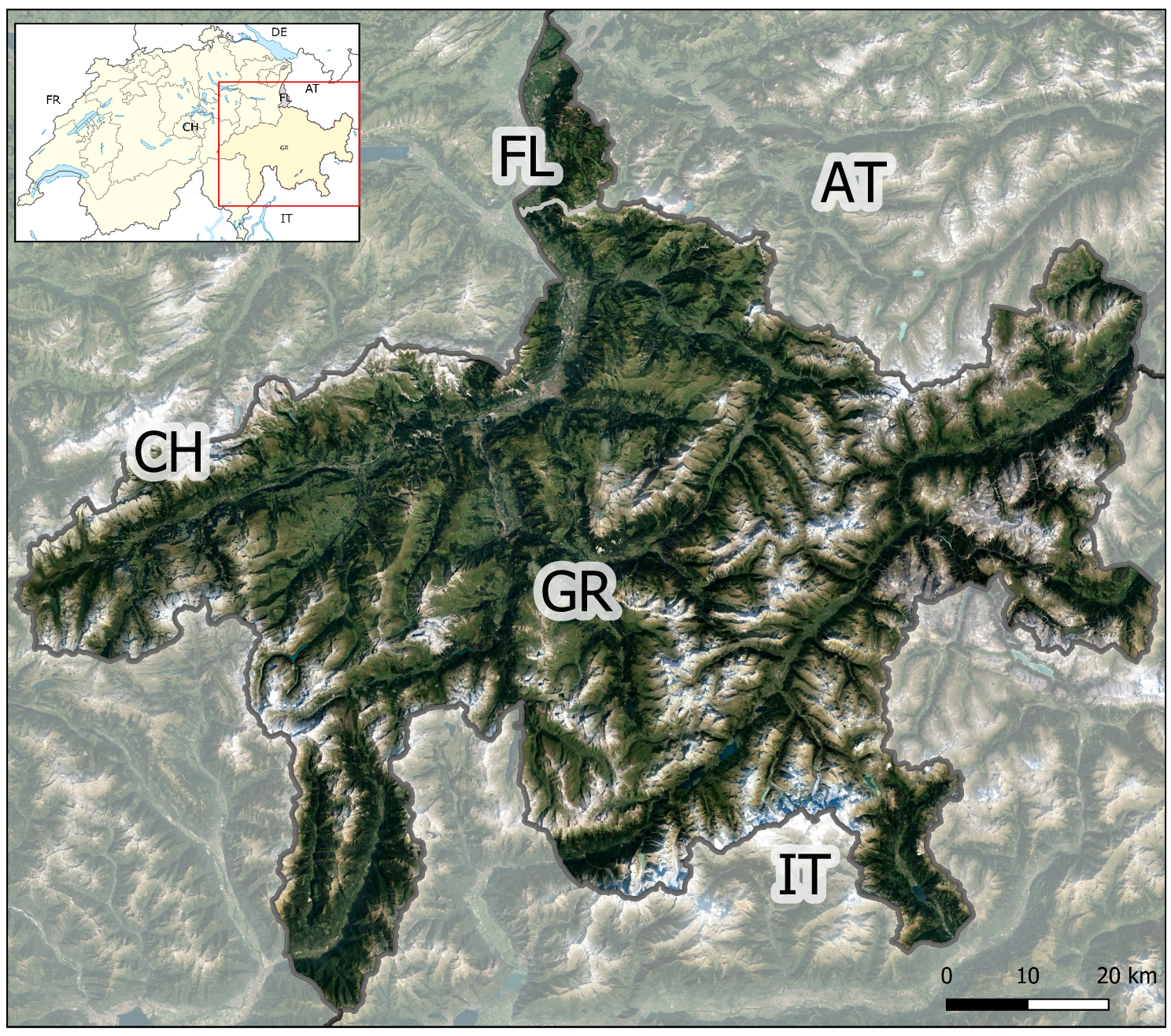
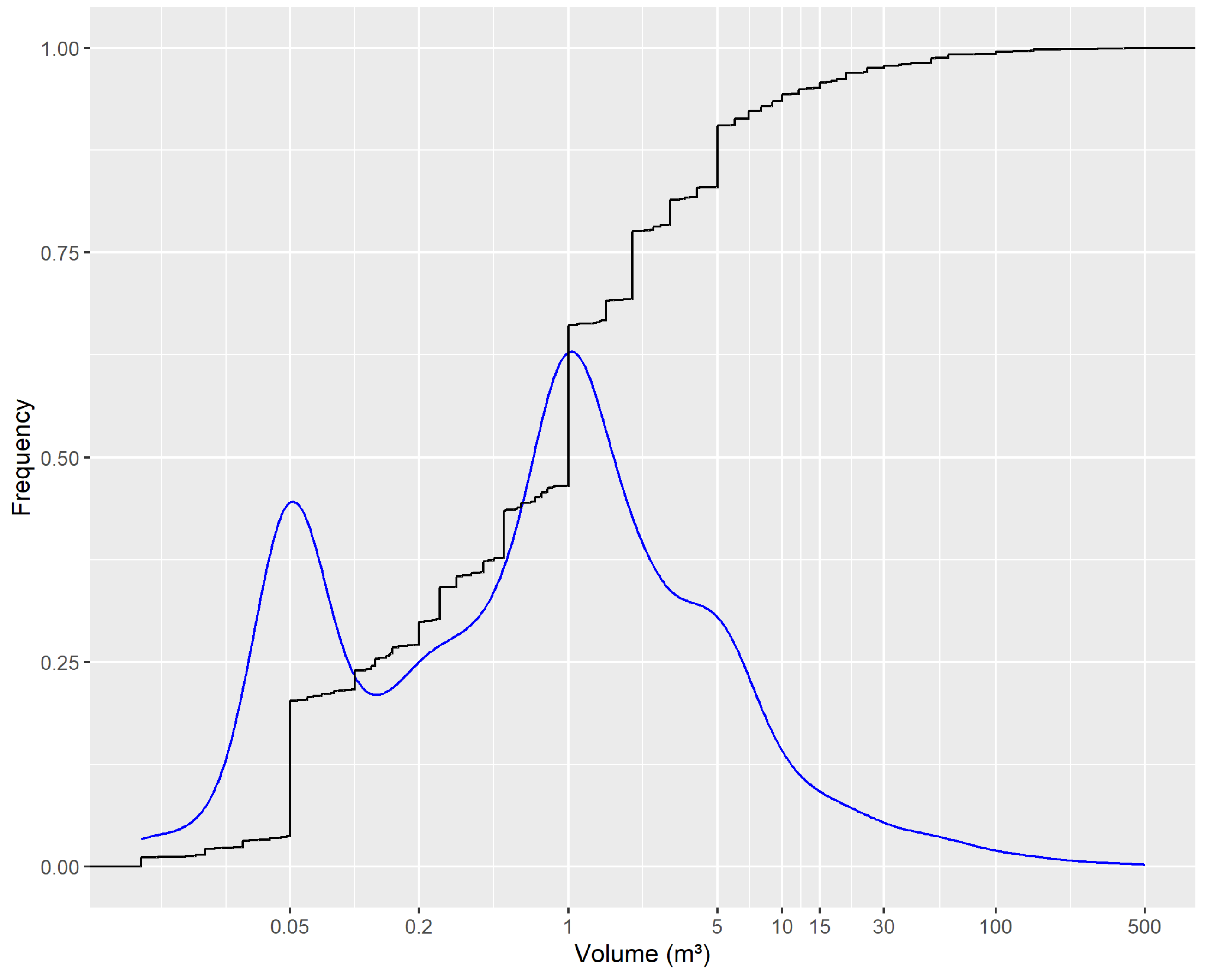

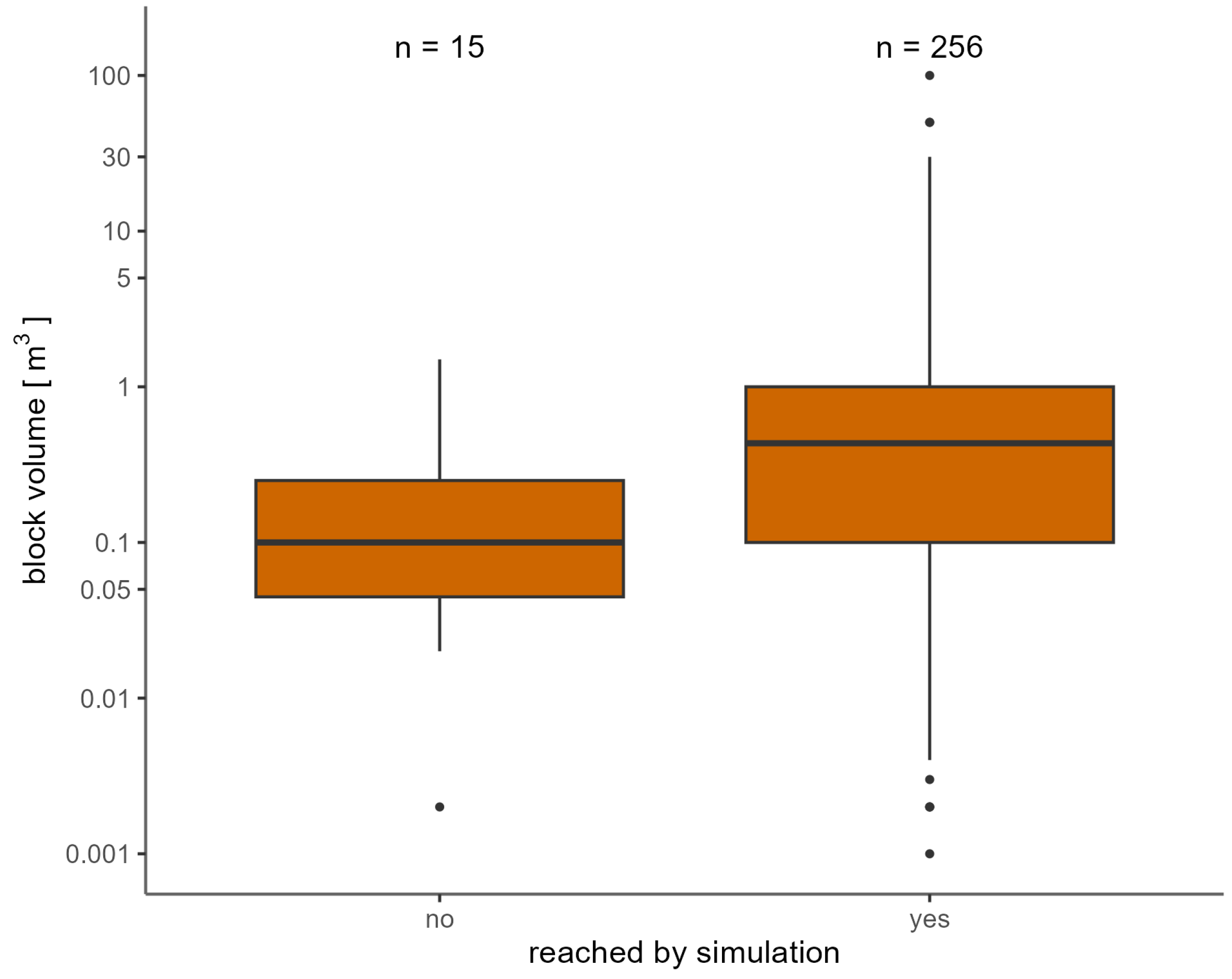
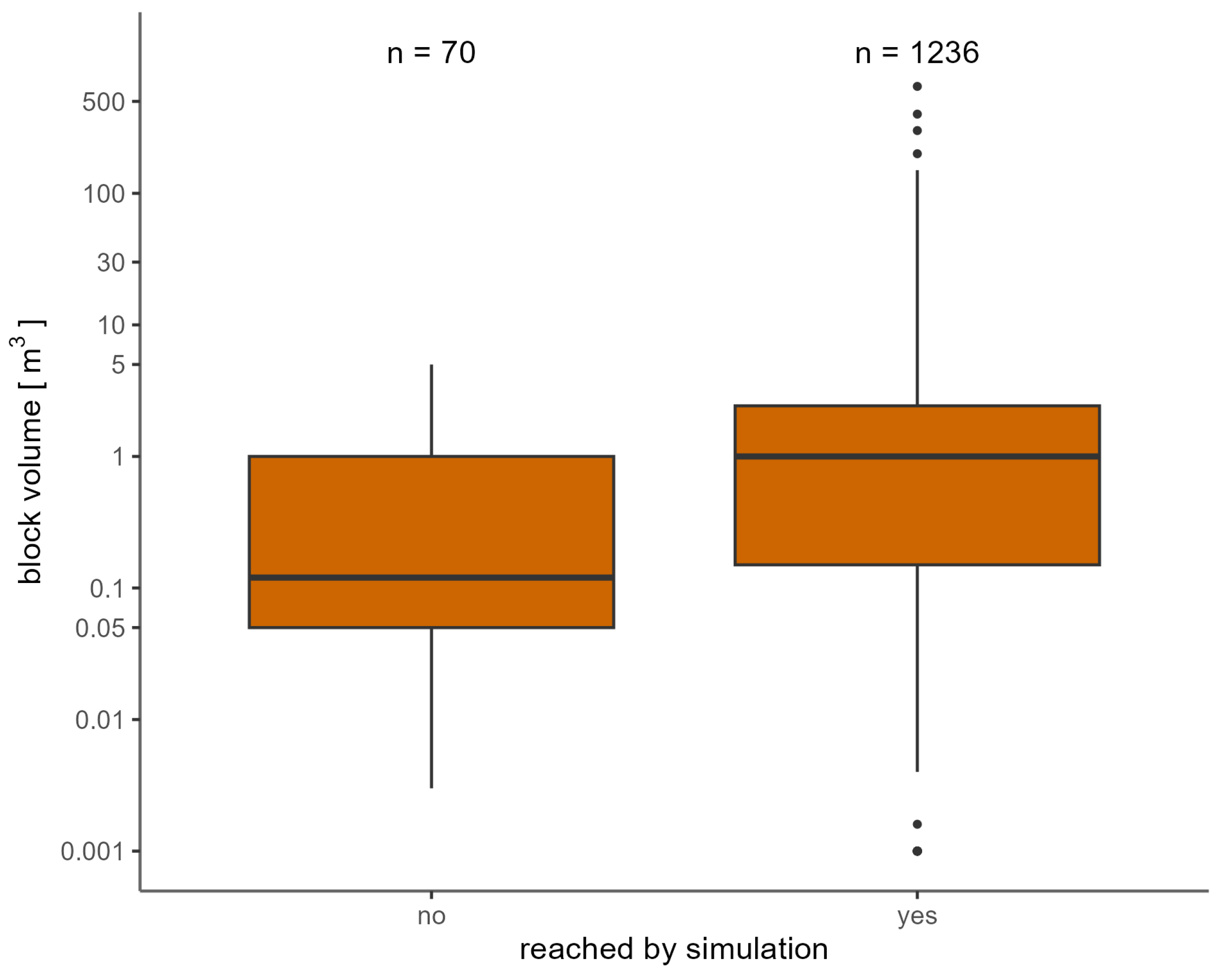
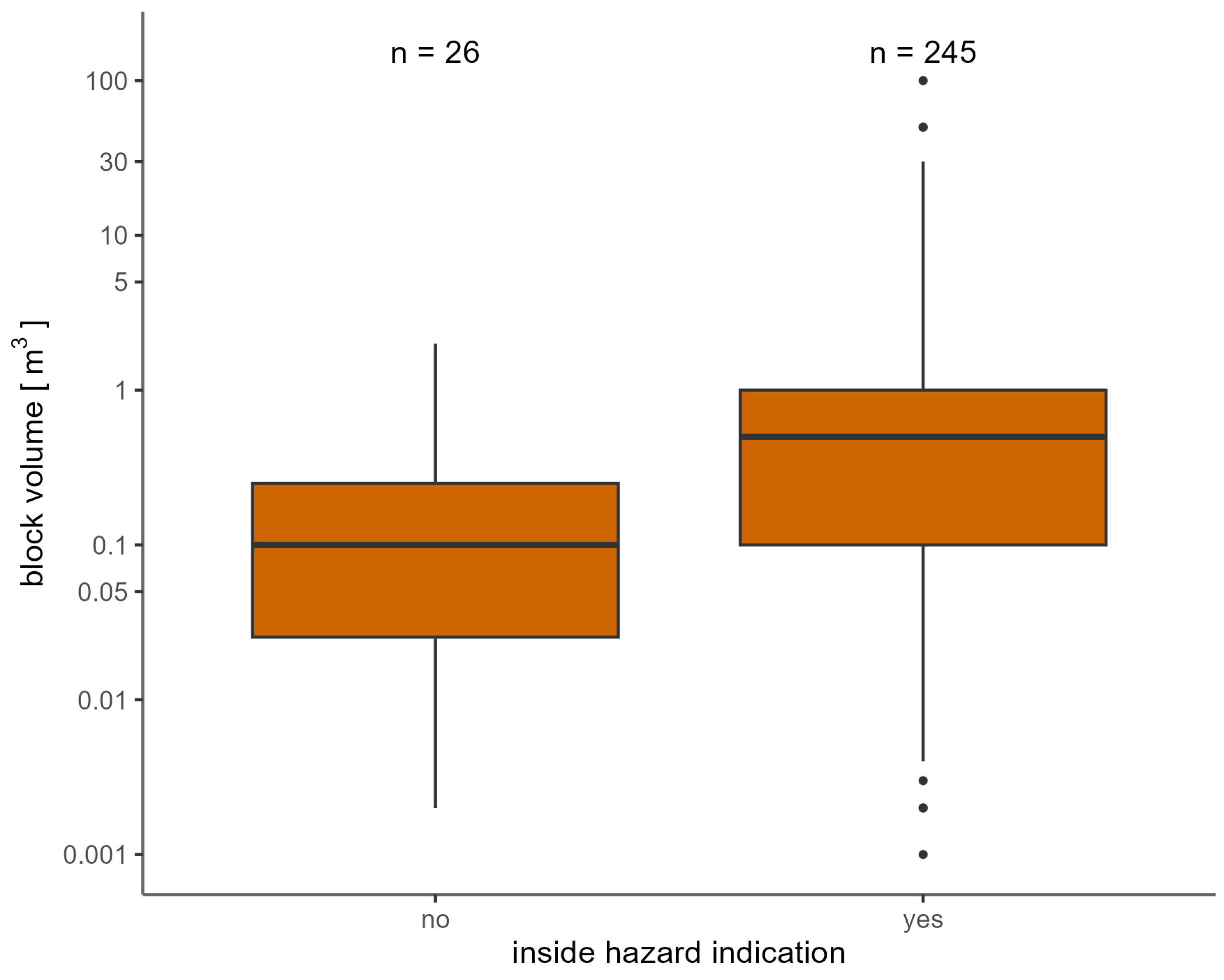
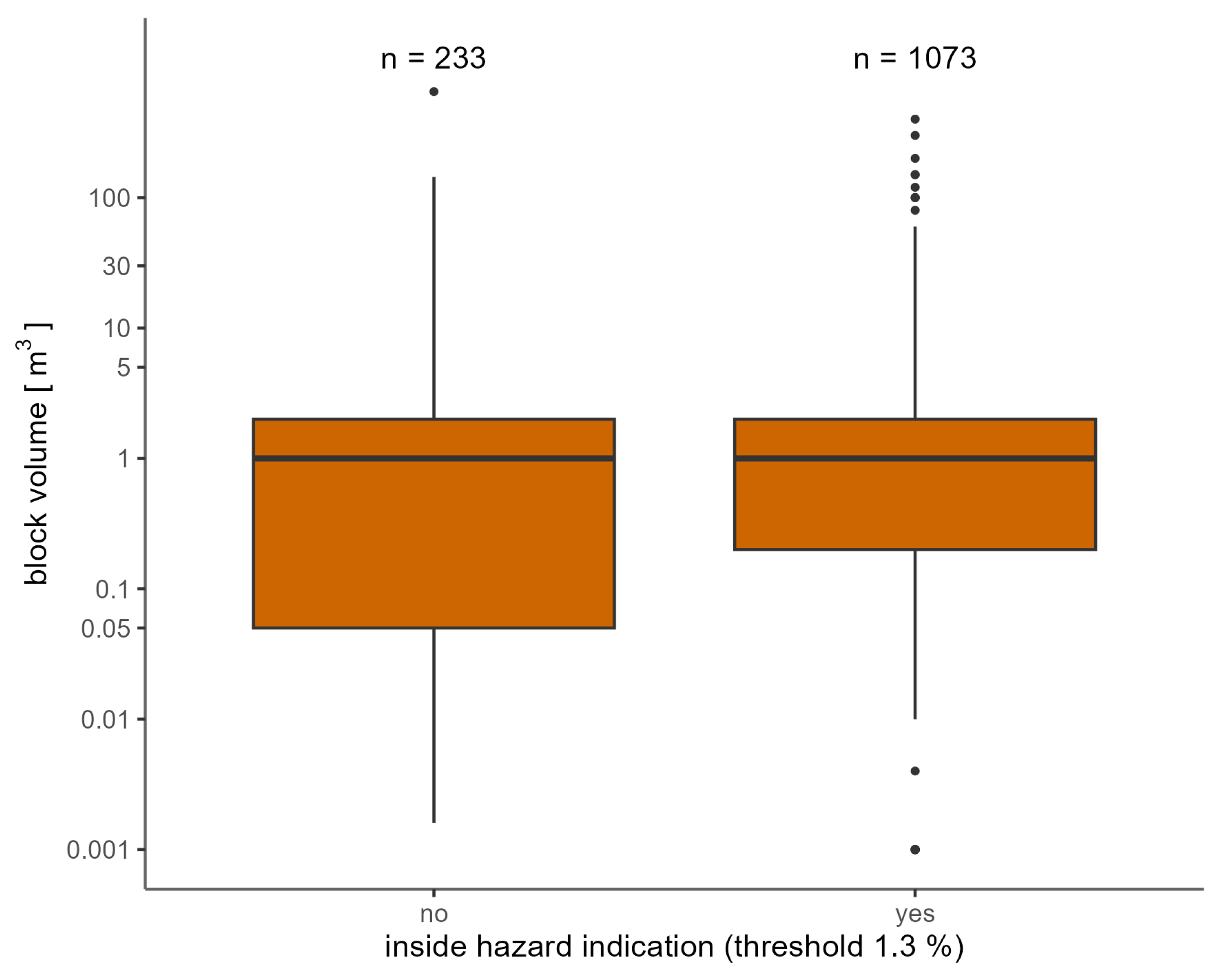
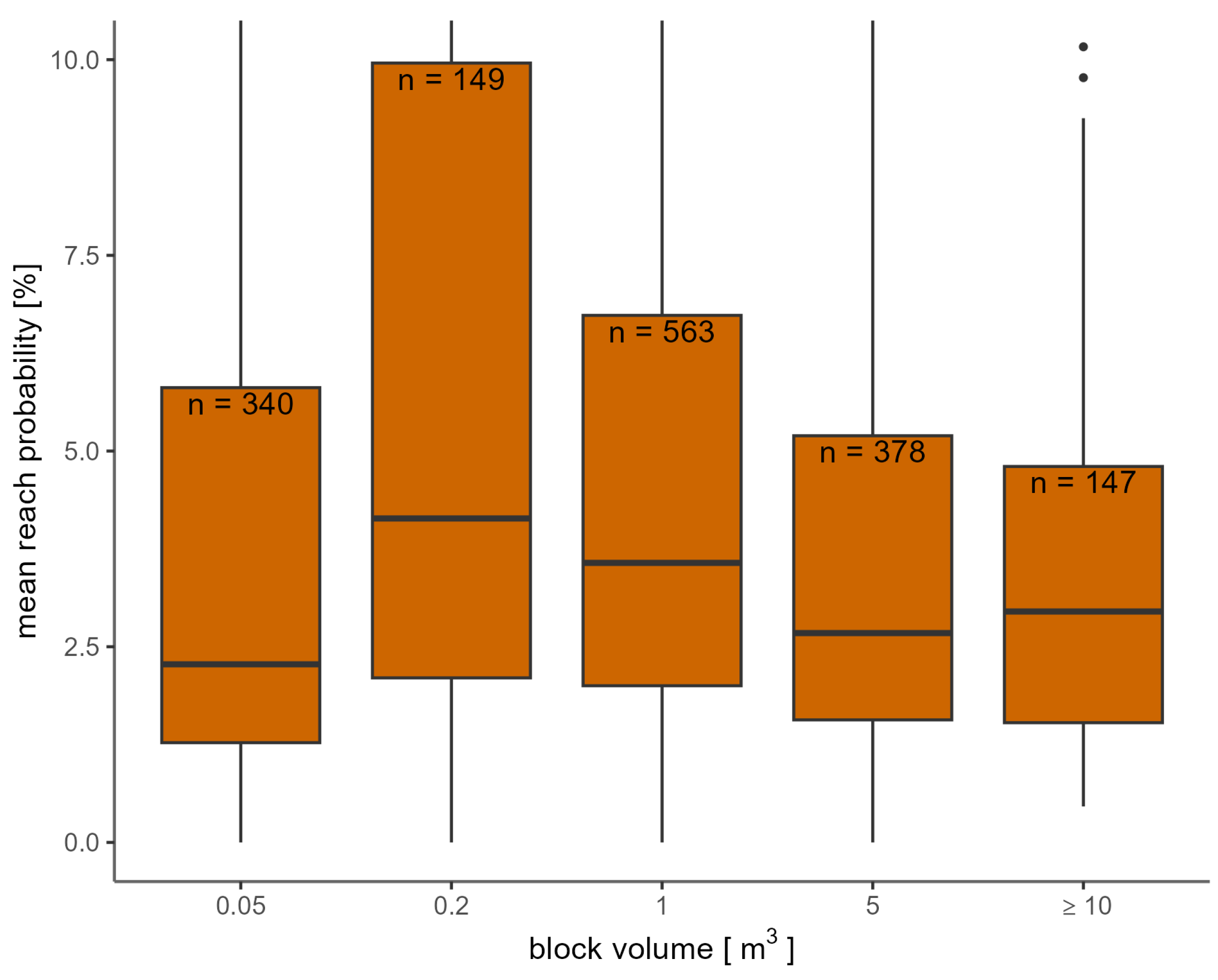

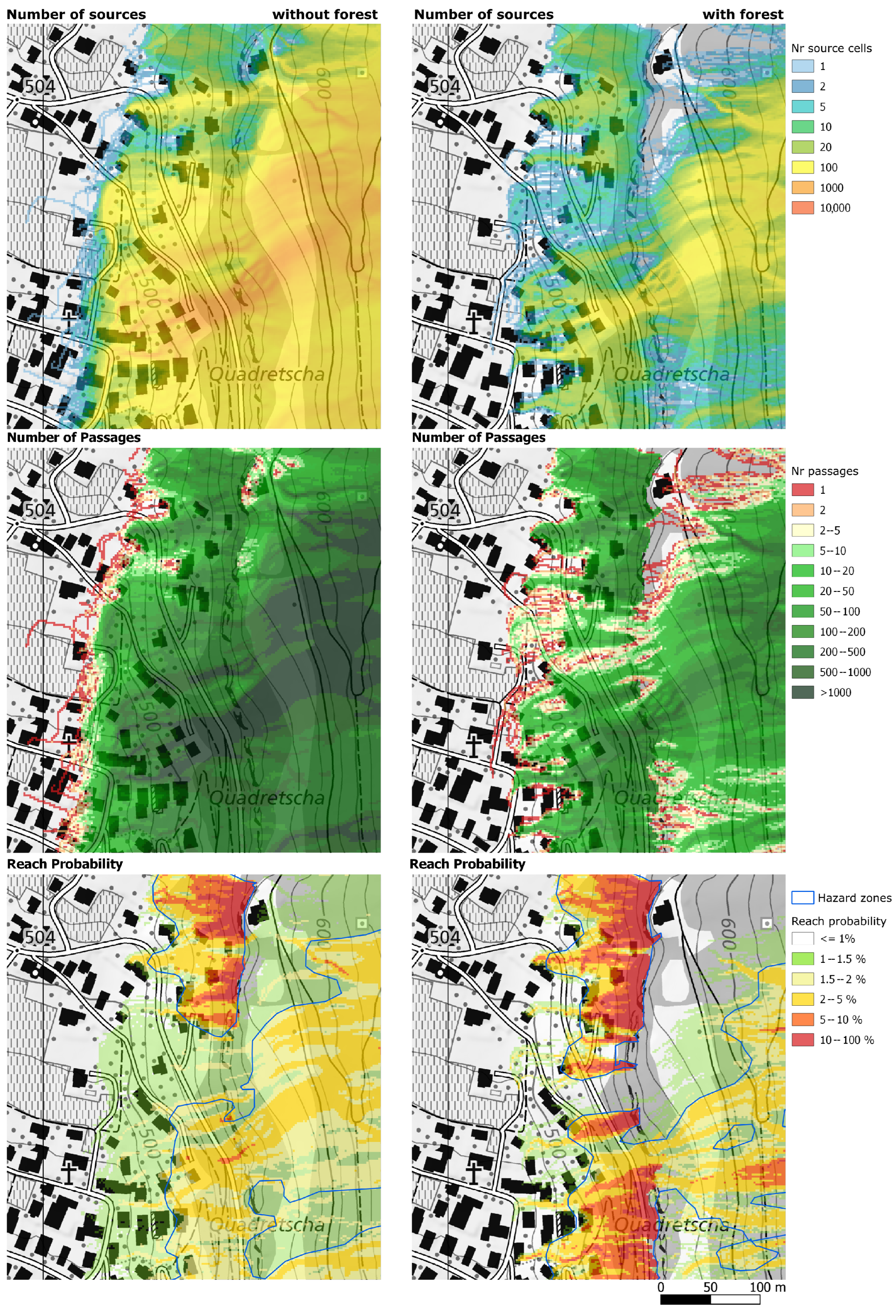
| Datasource and Criteria | Slope Material Characteristics | ||||
|---|---|---|---|---|---|
| Priority | Datasource 1 | Datasource 2 | Datasource 3 | Roughness Class | Soil Type |
| 1 | Start cells (Slope (0.5 m) ≥ 55) | Rock face, loose rock material or forest (TLM) | no roughness | 6 | |
| 2 | Roads (TLM) | - | - | no roughness | 7 |
| 3 | Railways (TLM) | - | - | low | 2 |
| 4 | Rock face (TLM) | - | - | no roughness | 6 |
| 5 | Loose rock material (TLM) | Bergsturz deposits (Geocover) | Slope (2 m) ≥ 25 | medium | 4 |
| 6 | Slope (2 m) < 25 | high | 4 | ||
| 7 | Scree and Talus deposits (Geocover) | Slope (2 m) ≥ 25 | low | 4 | |
| 8 | Slope (2 m) < 25 | medium | 4 | ||
| 9 | Forest (TLM) | Bergsturz deposits (Geocover) | Slope (2 m) ≥ 25 | medium | 4 |
| 10 | Slope (2 m) < 25 | high | 4 | ||
| 11 | Scree and Talus deposits (Geocover) | Slope (2 m) ≥ 25 | low | 3 | |
| 12 | Slope (2 m) < 25 | medium | 3 | ||
| 13 | Loose rock material (TLM) | Alluvial fan (Geocover) | - | low | 3 |
| 14 | Forest (TLM) | Alluvial fan (Geocover) | - | low | 3 |
| 15 | Rivers (TLM) | - | - | extreme | 0 |
| 16 | All other areas | Slope (2 m) 0–5, | - | no roughness | 1 |
| 17 | Slope (2 m) 5–25, | - | no roughness | 2 | |
| 18 | Slope (2 m) > 25 | - | no roughness | 3 | |
| Roughness Class | Rg70 Value (in m) | Rg20 Value (in m) | Rg10 Value (in m) |
|---|---|---|---|
| no roughness | 0 | 0 | 0 |
| low roughness | 0.05 | 0.1 | 0.2 |
| medium roughness | 0.1 | 0.2 | 0.4 |
| high roughness | 0.2 | 0.4 | 1.0 |
| extreme roughness | 100 | 100 | 100 |
| Diameter Class | Mean DBH [cm] | DBH Stddev [cm] |
|---|---|---|
| 12 cm ≤ < 24 cm | 18 | 1.6 |
| 24 cm ≤ < 36 cm | 26 | 2 |
| ≥ 36 cm | 38 | 10 |
| GR | FL | |
|---|---|---|
| Detected trees | 25,647,358 | 844,696 |
| Generated trees 12 cm < 24 cm | 20,311,009 | 792,410 |
| Generated trees 24 cm < 36 cm | 3,475,925 | 121,951 |
| Generated trees 36 cm | 6,374,732 | 156,162 |
| Total trees in tree file | 55,809,024 | 1,915,219 |
Disclaimer/Publisher’s Note: The statements, opinions and data contained in all publications are solely those of the individual author(s) and contributor(s) and not of MDPI and/or the editor(s). MDPI and/or the editor(s) disclaim responsibility for any injury to people or property resulting from any ideas, methods, instructions or products referred to in the content. |
© 2023 by the authors. Licensee MDPI, Basel, Switzerland. This article is an open access article distributed under the terms and conditions of the Creative Commons Attribution (CC BY) license (https://creativecommons.org/licenses/by/4.0/).
Share and Cite
Dorren, L.; Schaller, C.; Erbach, A.; Moos, C. Automated Delimitation of Rockfall Hazard Indication Zones Using High-Resolution Trajectory Modelling at Regional Scale. Geosciences 2023, 13, 182. https://doi.org/10.3390/geosciences13060182
Dorren L, Schaller C, Erbach A, Moos C. Automated Delimitation of Rockfall Hazard Indication Zones Using High-Resolution Trajectory Modelling at Regional Scale. Geosciences. 2023; 13(6):182. https://doi.org/10.3390/geosciences13060182
Chicago/Turabian StyleDorren, Luuk, Christoph Schaller, Alexandra Erbach, and Christine Moos. 2023. "Automated Delimitation of Rockfall Hazard Indication Zones Using High-Resolution Trajectory Modelling at Regional Scale" Geosciences 13, no. 6: 182. https://doi.org/10.3390/geosciences13060182
APA StyleDorren, L., Schaller, C., Erbach, A., & Moos, C. (2023). Automated Delimitation of Rockfall Hazard Indication Zones Using High-Resolution Trajectory Modelling at Regional Scale. Geosciences, 13(6), 182. https://doi.org/10.3390/geosciences13060182








